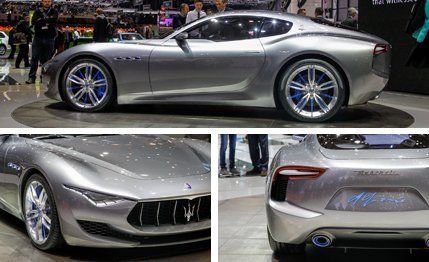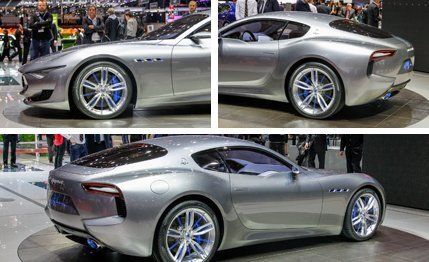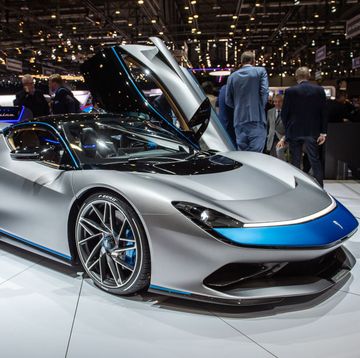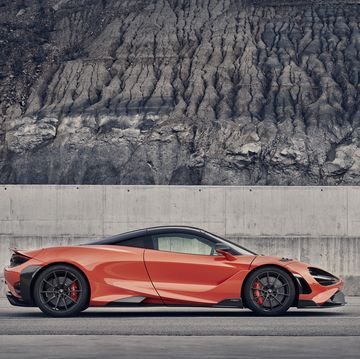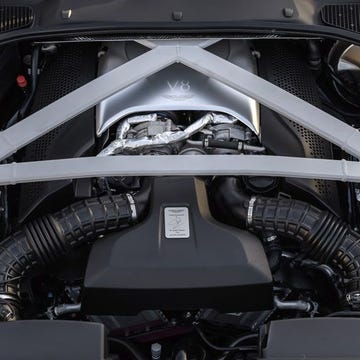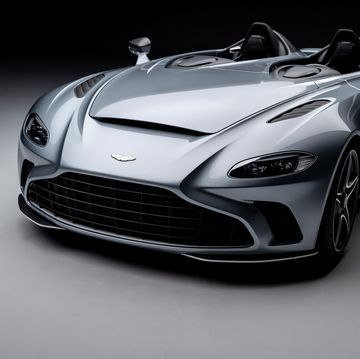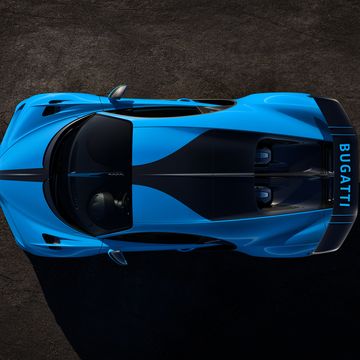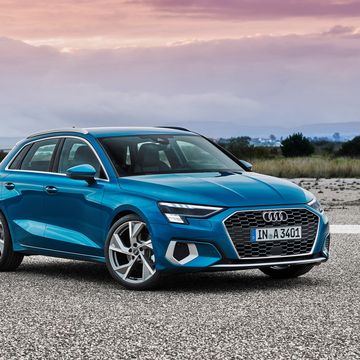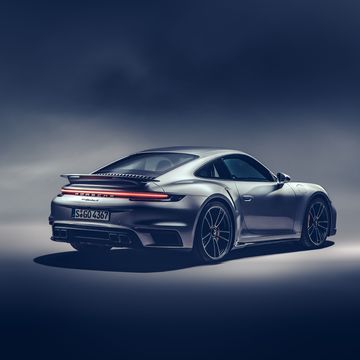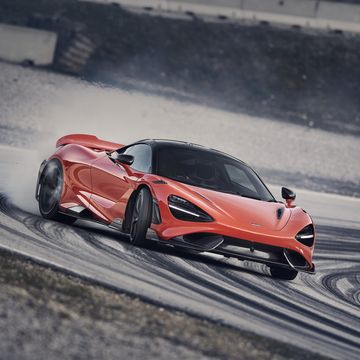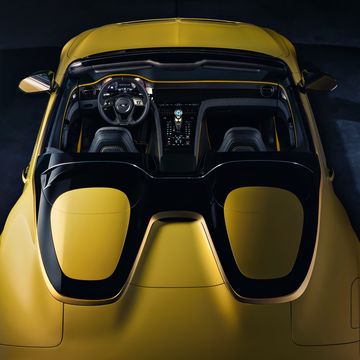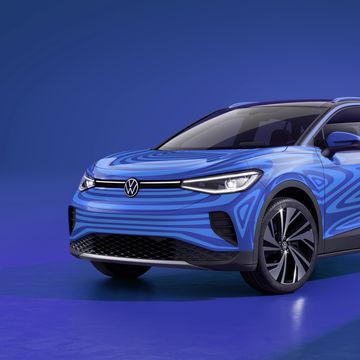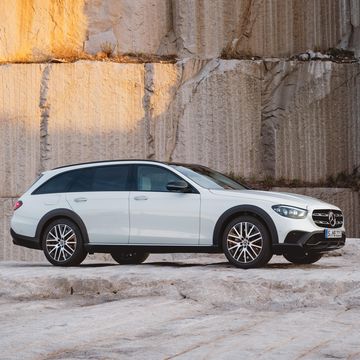“This car has a foot pedal that is hungry to be floored.” That’s Maserati boss Harald Wester, speaking in reference to the go lever in the Maserati Alfieri concept that stole this year’s Geneva Motor Show. While that seems clear, what we really want to know is how Wester and the gang at Maserati managed to keep it completely under wraps. Right up to the day of the show, the Alfieri was still just rumor floating through cyberspace. But now it’s here and it’s oh-so-sexily real, and we were close enough to feel the crowd vibrate when it rolled into view for the first time.
Created at Maserati Centro Stile in Turin by a small group of designers led by Marco Tencone, the Alfieri project was masterminded by styling legend Lorenzo Ramaciotti, the now Fiat-Chrysler design boss whose resume also includes tenures at Pininfarina and Ferrari. Development began last summer, when designers were asked to start from a blank sheet to create a concept to honor Maserati’s centenary. Those sketches led to what you see before you, which its maker claims is a “100% functional prototype that says much about the design DNA of future Maseratis.”
Namely Speaking
Maserati aficionados will recognize the Alfieri name as a tribute to Alfieri Maserati, the engineer who founded “Officine Alfieri Maserati” in Bologna a century ago, and, with varying degrees of help from his five brothers, put the trident brand on the map. To pay tribute to Maserati’s long history, the Alfieri concept carries forward the same attitude and 2+2 style of the 1957 3500 GT and the 1959 5000 GT. In the wake of the recent mainstream sales waves made by the Quattroporte and Ghibli sedans, Maserati wants to ensure no one forgets the brand’s racing heritage and tradition of exotic GT cars.
Based on the GranTurismo MC Stradale chassis, the Alfieri’s wheelbase is nevertheless 9.4 inches shorter at 106.3 inches. It’s 180.7 inches long overall and sits 50.4 inches high. The Maserati GranTurismo lends its 4.7-liter, naturally aspirated V-8 to the cause, and the engine sends 460 horsepower and 384 lb-ft of torque through a six-speed automated manual gearbox and a limited-slip rear differential. The layout is said to give the Alfieri a very slight rearward weight bias. The Alfieri’s carbon-ceramic brake discs come directly from the GranTurismo MC Stradale and are pinched by Brembo brake calipers.
Sultry Goodness Outside
The exterior details seem to align with Maserati’s mission. A long, low nose is punctuated with a grille that is futuristic yet undeniably Maserati. The same can be said for the exterior finish, a color called Steel Flair, selected to look “as if a metallic veil has been draped over a naked body”—which also describes a Danzig video we once viewed, or think we viewed, late at night after taking a double dose of cough syrup. But we digress.
The restyled triple air ducts on the wheel arches are finely integrated so as to not clutter the design. Bi-xenon LED headlamps light the way, their characteristic eyebrow detail repeated on the twin exhaust tailpipes. The taillamps are three-dimensional units, comprised of two red external elements and one white internal element. Shaped to follow the rear shoulder of the car, they combine with the air ducts underneath with stylish but purposeful grace. The front spoiler and rear diffuser are carbon fiber with aluminum inserts. Staggered-diameter, forged aluminum wheels measuring 20 inches in front and 21 inches at the rear feature decorative spokes said to be a subtle nod to the designs of the 1950s. What’s more, the decorative spokes of the wheels, the brake calipers, the grille, the iconic triple air ducts, the rear diffuser, and the provocative eyebrow of the exhaust pipes are all finished in Maserati Blue. The blue Alfieri signature on the rear of the car is said to have been reproduced from archived materials at Maserati.
Focused Design Inside
The handmade 2+2 interior carries forward the minimalistic ethos, only in shades of Luna white and dark Basalt blue. Aniline leather on the seats, dashboard, and central console stands in contrast to the floor, which is finished in a material that imitates oxidized steel, a material commonly used on racing cars of the 1950s. The dashboard boasts a two-tone design built around a very modern central TUFT screen, yet is said to be inspired by the dash in the Maserati 5000 GT. TFT displays replace traditional analog gauges, and the numbers—rather than the needles—rotate with speed and RPM highlighted by a magnifying-glass effect. An impressive piece of visual fun, but we feel a car like this just cries out for a set of elegant analog gauges. Seat garnishes, the gearbox lever, and an oval clock on the central console are milled from single-piece aluminum billets, and are hand-finished and anodized in a natural copper color. All other aluminum components, including the pedals, gearbox paddles, and steering wheel spokes are anodized in a palladium color.
Sportier than the GranTurismo, Maserati’s bullish on this sports coupe. Weighing in on the possibility of production, Ramaciotti says, “I sincerely can’t say that we’ll see this car in production in two years’ time, but I’m certain we’ll see something very similar.” Wester, in perhaps a revealing slip, explained that the car is not a GT but a perfectly sized 2+2 that will compete—before instantly backtracking and changing “will compete” to “could compete”—in a new class for the maker, one in which it would go trident-to-claw with Jaguar’s seductive F-type coupe. While we have no conclusive evidence as to whether the concept is roadworthy, its seductive exhaust note, sampled when the car idled to center stage, is clearly ready for public consumption. People, start your checkbooks.

Andrew Wendler brings decades of wrenching, writing, and editorial experience with numerous outlets to Car and Driver. His work has appeared in numerous publications, including Car and Driver, Esquire, Forbes, Hot Rod, Motor Trend, MPH, MSN, and Popular Mechanics, among others. A Rust Belt native and tireless supporter of the region, he grew up immersed in automotive, marine, and aviation culture. A lifetime of hands-on experience and a healthy dose of skepticism provide him the tools to deliver honest and informative news, reviews, and editorial perspective. Of note, he once won a $5 bet by walking the entire length of the elevated People Mover up track that encircles downtown Detroit.

